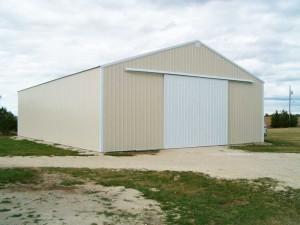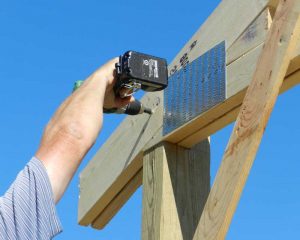How Advice Columns Get Interesting…
Just last week, I shared a question from TOM (a reader who reads my blog) in regards to finishing the inside of a fairly recently constructed post frame (pole) building. The dialogue has continued.
Tom: “Obviously drywall for the ceiling would be a wiser choice. The truss manufacturer said the trusses were rated for steel 29 gauge panels and blown in insulation, at .65 lbs per square foot for 29 gauge versus 1.28lbs. per square foot for ultra light sheetrock.I’m tempted to roll the dice and go with sheet rock as it would only add 780 lbs of total load to the trusses. Of course with customer approval and he is a certified engineer. Truss manufacturer says it would void warranty. I’m sure they build with an overage percentage factored in but they wouldn’t say how much because of the liability involved.
Customer wanted drywall originally, but because the ball got dropped somewhere with the lumber supplier, the trusses shipped were under rated.
In the event that we go with the steel, would you advise a vapor barrier above the panels? Also would cellulose or fiber glass blown in be the wiser choice? Would the barrier be necessary with painted drywall”?
Trusses are not designed/built with an “overage percentage” factored in. For any wood structural product for construction, we are able to only design for what is known as 40% of Pultimate (very simplified, it is 40% of ultimate failure strength). This is to account for all of the variabilities in lumber, as well as errors in either fabrication, or utilization on the jobsite. The published values used by engineers are already adjusted to this number.
The potential for receipt of “under rated” trusses is huge when purchased from a lumber supplier, rather than a firm which specializes in post frame buildings and has the knowledge to ensure the trusses ordered match the needs of the building and the building owner. In general, buying trusses from a lumber yard is going to be a gamble, which might leave one grossly disappointed in the results.
Me: “Can you scan and email the truss drawings to me please?
The problem with steel liner panels is the warm moist air inside of the building will condense on the underside of the ceiling liner panels. With a sheetrocked ceiling, a vapor barrier should not be installed between the sheetrock and the trusses. I like fiberglass personally, but either should work. FYI – Lightweight 5/8″ drywall is 1.65 psf (1/2″ will sag on a ceiling spanning 2′).”
Tom: “Here you go Mike, I appreciate you looking into this. One of my thoughts on strengthening the trusses was OSB gussets. There will be a huge 6′ ceiling fan in the woodstove area to help with the condensation issue.
I intend on laying 2×6 on 2′ centers flat to hang whatever goes on or do they need to be on edge. I know edge would be best, was going on lumber supplier’s estimator’s opinion.
Thanks again Mike”.
Me: “Thank you very much. The two psf they designed the bottom chords for would be questionable even to support a steel liner ceiling. For a small nominal fee (usually $25-50), they can design an engineered “repair” to increase the bottom chord dead load to five psf, which would support the sheetrock and any needed framing. The truss bottom chords are stressed fairly close to 100%, so do not be surprised if you have to add some additional webs to the truss, or a “scab” alongside of the bottom chord. Whether you use a steel ceiling or sheetrock, the joists between the trusses should be placed on edge, flat they would overly deflect and your client would not be pleased with the resultant.”
Tom: “Hi Mike, Thanks so much for giving this your attention and advice. I am not an engineer but have been curious about laminating osb to the bottom chord and up the webs, say a foot. I joists are made with osb, I’m sure not a common grade, and I’m thinking it should help considerably. I’ve thought about trying it on my own house’s sagging floor joists by jacking them straight then laminating at least one side just as an experiment.
Could you do the repair engineering if necessary?”
Me: “Your laminations would only work if you were able to do so without a splice, or to overlap panels (two deep) with staggered splices. If you will notice I joists do not have splices in the OSB webs. On the truss, you would basically end up sheeting one entire side of each truss, with two layers of OSB. The truss repair engineering would be best done by the truss manufacturer (who is actually going to have the truss plate manufacturer do the repair and seal the drawing). It will be quickest and least expensive, both in terms of the cost of the engineering, as well as the amount of materials and time involved.”









